Affiliate disclosure: This post may contain affiliate links. Please see our Privacy Policy.
Tomato pests and diseases can be frustrating, and left untreated they can result in the loss of a whole crop. Learn these simple organic treatments for common tomato pests and diseases to keep your plants thriving!
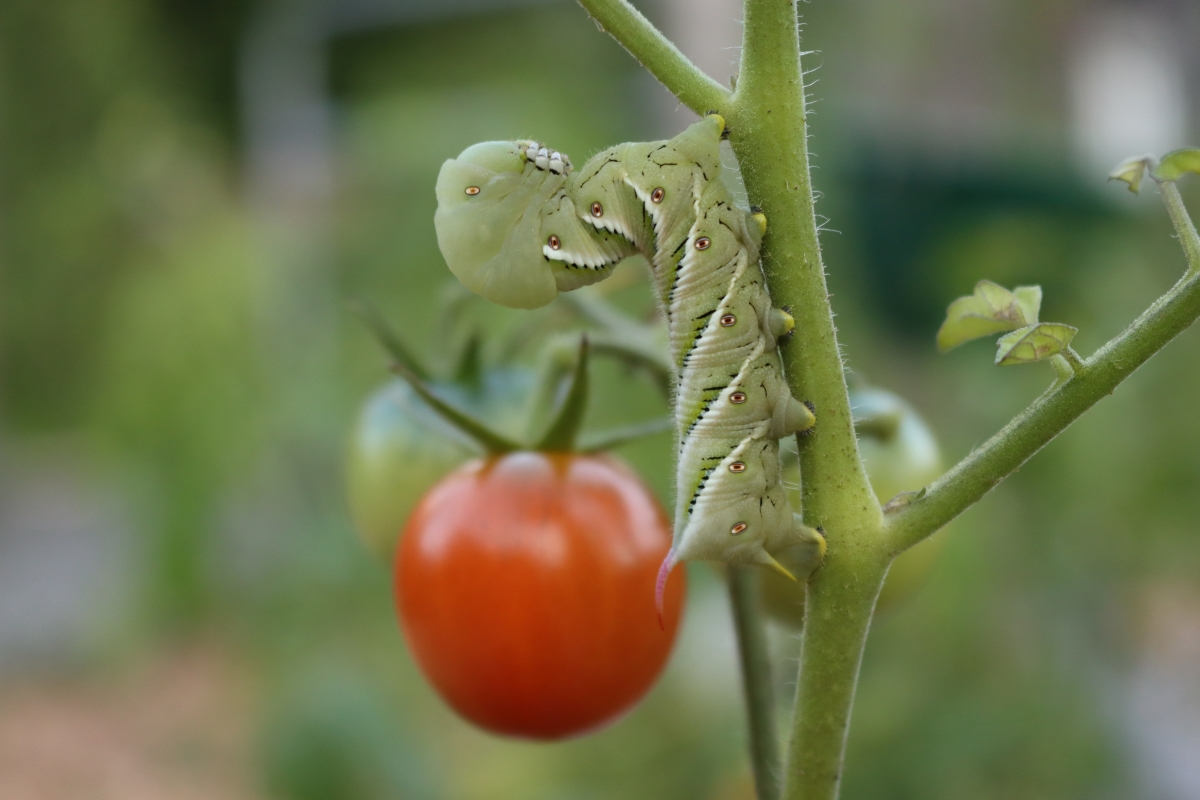
The following was contributed by Bethany at Family Growing Pains. Bethany blogs about gardening, home preserving, and raising backyard chickens on her small homestead.
Tomato plants come with several common tomato pests and diseases that can damage or kill all of your plants. Growing tomatoes isn’t as easy as you might think; you need to keep a constant eye on your plants, looking for any signs of diseases or pests. Responding quickly to infestations is key to maintaining the health of your plants.
That’s part of the problem.
Most of the treatments you’ll find for tomato pests and diseases are based on the use of chemicals, and when you’re an organic gardener, chemicals don’t fit into the plan. Most organic gardeners only use chemicals during an emergency, and even in those cases, some might prefer to remove their crops rather than use a non-organic treatment.
Most gardeners want to grow tomatoes, so you need to be prepared to face these common tomato pests and diseases. Everyone encounters them at some point, so having an organic treatment plan ready is smart.
Let’s take a look at some of the pests and diseases that infect tomato plants and how you can treat them organically.
Common Tomato Pests: How to Treat Them Organically
One thing I think is important is learning how to identify the insects you find in your garden. Despite your gut reaction, many insects you find in your garden aren’t a pest that needs to be killed. Beneficial insects exist, and we don’t want to kill those. You also might find neutral pests, who don’t benefit nor harm your garden, and they’re welcome to hang around.
I keep my phone with me when I’m gardening, and I try to take pictures of the insects I see. This year, I finally found a few spiders in my garden, and I snapped a few pictures. Then, I learned about why garden spiders aren’t a bad thing to have.
Before you jump to killing off the insects, make sure they’re genuinely problematic. The ones listed below commonly visit tomato plants and need to be treated.
Aphids
If you find a cluster of tiny insects on the stem or underside of the leaves, chances are you have aphids. Most gardeners will encounter aphids at some point; they infect nearly any plant you can grow in your vegetable garden.
They can be easy to miss because of their small size, but the aphid population starts to grow over time. Aphids are no big deal in small numbers, but as the infestation grows, the situation becomes more serious. Large infestations damage or kill mature tomato plants.
Aphids like to attach to the underside of leaves because it gives them a way to suck out the sap from your plant. The insects then leave a sticky substance on the leaves called honeydew, which attracts sooty mold and ants.
How to Organically Treat Aphids
Treating aphids can be a bit tricky, but here are a few options to try.
- Cut off the leaves and stems that the aphids have destroyed or where they are spending most of their time. Put them in a garbage bag or trash can, NOT your compost pile or the ground.
- Spray your plants with a jet of water from the hose, knocking the aphids off of the plant. Be careful not to break your plant.
- Consider releasing beneficial insects that can take care of these pests, such as ladybugs or lacewings.
- Use insecticidal soap to scrub the plant off; the oils and fats in the soap help to get rid of them.
- Try a natural spray, such as Neem oil, to keep aphids from coming back to your plants.
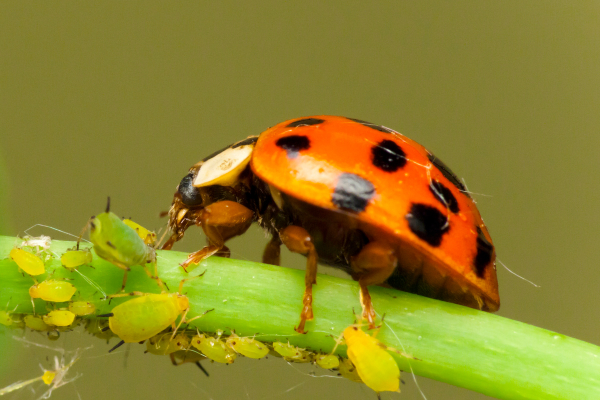
Cutworms
Cutworms look like small caterpillars that like to feed on tender plants and the stems of new plants at night. They’re efficiently at eating seedlings in a single night, right to the ground level.
Eggs hatch in the fall, and the larvae can overwinter in the soil easily. The damage appears early in the gardening season because, as soon as they emerge from hibernation, the cutworms start to eat.
It’s easy to think that cutworms are grubs accidentally. There are different species because cutworms are immature moths. They range in color from grey to pink, green, and black, measuring up to two inches long. Cutworms can be solid, striped, or spotted, and if they aren’t on the move, they’re usually curled up.
How to Organically Treat Cutworms
With cutworms, the best treatment is an excellent preventative plan. If you spot a few cutworms in your soil, you’ll want to take steps to prevent any damage to your plants.
- Putting a collar around your seedlings is a good first step. You can make a collar out of paper, cardboard, or aluminum foil. Sink the collar into the soil about 1-2 inches deep with three inches above the ground.
- Go out at night and handpick any of the cutworms you see. They emerge from the ground at night, so it’s the easiest time to spot them. Drop them into soapy water when you do find them. Try this for several nights in a row.
- You can try sprinkling coffee grounds, eggshells, or diatomaceous earth around the stems, but keep it off the stem. They don’t like to move over these substances.
- Another option is to use BT, Bacillus thuringiensis, as a natural way to kill them, but be careful because it can harm butterflies.
Flea Beetles
Here is another common tomato pest – the flea beetles. They look like jumping fleas.
The problem with flea beetles is that they attack all parts of your plant. The adult flea beetles eat the plant’s foliage, so you might find dozens of little holes throughout the growing season. At the same time, the larvae feed on the roots of the plant.
Another issue with the flea beetles is that they aren’t picky; they’ll eat anything. From corn to tomato plants, if it’s in their wake, flea beetles will start to munch and destroy the plants.
How to Organically Treat Flea Beetles
The first thing you should do is clear away any weeds or debris left in your garden. Debris allows adult flea beetles to overwinter. Aside from using this as a preventative measure, here are some other ways to get rid of flea beetles in your garden.
- Put out sticky traps to trap the adult beetles as they jump and fly around.
- You can put row covers over your garden beds to protect the vulnerable plants. Covering the garden beds will keep the beetles away.
- Dust the plants with diatomaceous earth to help control the adult flea beetles that are feed on the foliage.
- You can introduce beneficial nematodes into the soil of your garden which eat the juvenile forms of the flea beetles.
Hornworms
Perhaps one of the best-known tomato pests is hornworms. Hornworms are big, typically three inches long, making them easy to pick off your plants. However, hornworms are a pale green color, making it easy to camouflage on the plant. The light color makes it hard to spot the young, juvenile stages; it’s like trying to spot a needle in a haystack!
If you find hornworms on your tomato plants, they may have come from the previous year. The eggs can hang out in the soil and appear when the weather starts to warm up.
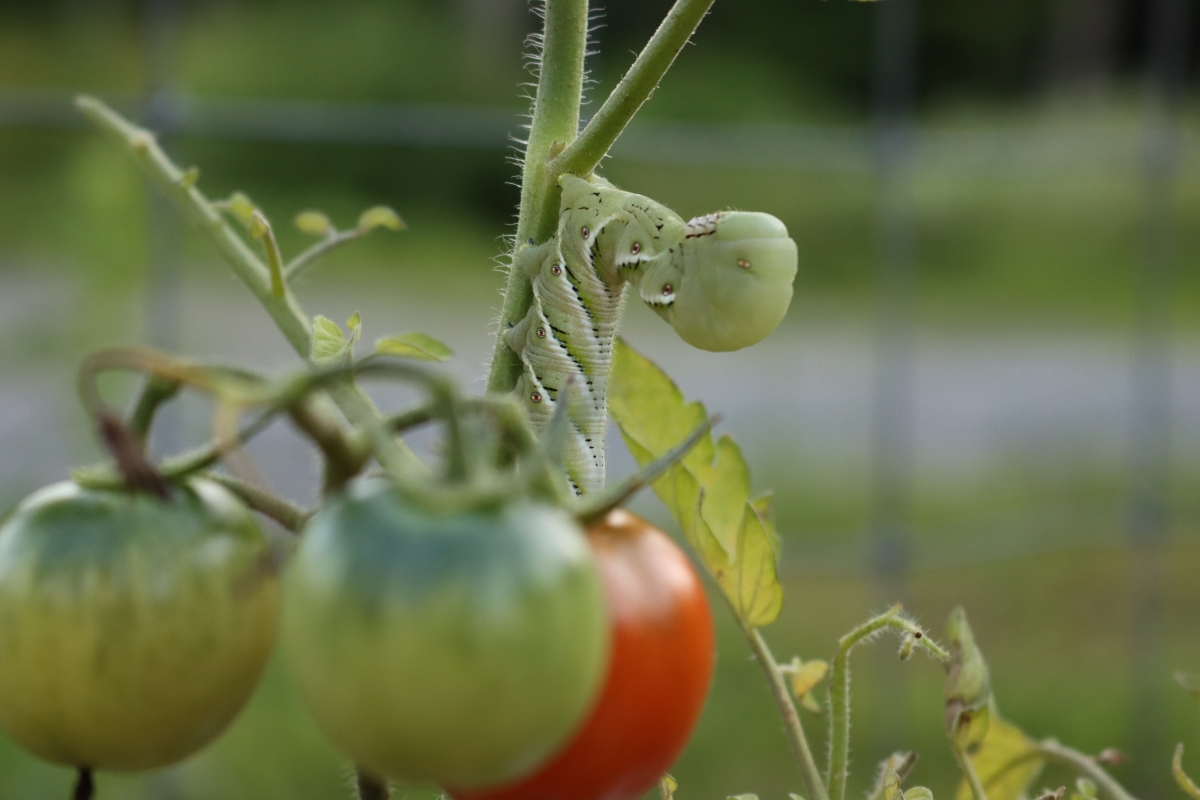
How to Organically Treat Hornworms
So, what can you do to treat hornworms organically? The first thing you need to do is pick all of the ones you can see off the plant. They cannot bite, nor do they sting; they have mouths designed for chewing soft leaves.
Since hornworms blend in easily, check the tops of the leaves and undersides as well as the outer branches. Look under chewed up foliage; hornworms eat the outer branches early and move to the plant’s interior when night approaches. If you spot hornworms, check your plants daily.
- An organic treatment that you can try is the use of BT, or Bacillus thuringiensis, to control some of the hornworms and other caterpillars. However, BT typically only controls young tomato hornworms. Mature ones often survive.
- Since we know that they can hide under the soil surface, it’s best to pull up the plants at the end of the growing season. That can expose the pupae, causing them to die.
- You can release beneficial insects, such as lacewings, Trichogramma wasps, and ladybugs. These will attack the eggs, but it works best when the pest levels are low.
- Encourage habitat for beneficial insects by planting a pollinator row. Some types of wasps prey on hornworms, and other insects parasitize them which will help keep them in check.
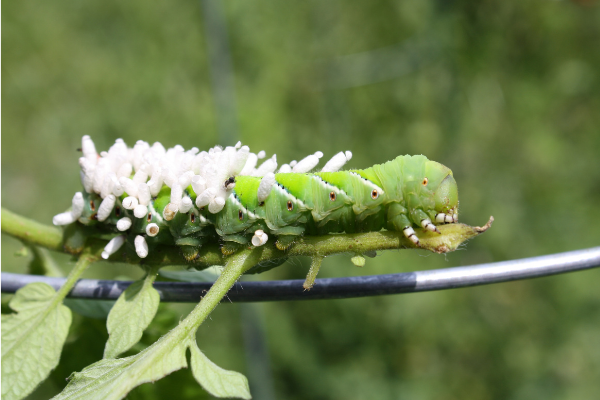
Nematodes
Without a doubt, one of the hardest and worse tomato problems that you can encounter is nematodes. Technically, there are thousands of types of nematodes that we know about globally, but only a few of them will cause gardening issues. Some nematodes are beneficial and help you control pests, like flea beetles and fungus gnats.
The most dreaded species is the root-knot nematode, which invades different crops. It leads to bumps and knots on the roots that destroy the plant’s ability to bring up the nutrients needed to grow while preventing photosynthesis.
How to Organically Treat Nematodes
Unfortunately, controlling and treating nematodes is difficult. In most cases, you need to actively prevent nematodes because control methods tend not to work as well.
Here are some suggestions.
- It tends to take several seasons for nematodes to establish in your garden. One of the best preventative methods is to rotate garden crops. Don’t plant in the garden bed with any veggie that is in the same family. So, after tomatoes, don’t plant peppers, eggplant, or potatoes.
- Add other nematodes. This seems strange, but if you order nematodes that are resistant varieties, they won’t kill the pests, but it will keep the effects of the harmful ones under control.
Whiteflies
If you shake your tomato plants and little flying insects come out, then you know you have whiteflies. These tiny little pests like to feed on your plants, leaving behind a sweety, tacky substance, which is called honeydew. That tends to encourage sooty mold and ants.
If you have whiteflies, it’s tempting to use insecticides, but don’t do it! Many whiteflies have a resistance to chemicals.
How to Organically Treat Whiteflies
- The best plan of action is to use horticultural oil, killing all stages of development of these pests. That’s an organic option.
- Another choice is to hang sticky traps around your garden, trapping the whiteflies on them.
- You can let natural predators out into your gardens, such as ladybugs, lacewings, or whitefly parasites.
- Another option is to use insecticidal soaps to decrease the population, but it won’t eliminate them. At that point, you can use natural predators to take care of the rest of them.
Common Tomato Diseases: How to Treat Them Organically
Tomatoes carry a range of diseases, with 30 being the most common. With so much against them, it’s hard to believe that tomato plants are ever healthy.
The best defense is a good offense, especially when it comes to tomato plants. Your plants need good soil full of nutrients, and you need to water your plants regularly. Healthy plants resist diseases better than sick plants. Weeding and keeping your garden beds free of debris will help keep pests and diseases at bay.
The most important thing to remember is always to avoid watering your plants’ foliage, especially if you live in humid climates. Diseases tend to prefer damp, cool conditions; fungi prefer these conditions. It’s best to water in the morning to discourage these conditions.
Blossom End Rot
If you notice fruits developing with a dark spot at the end that eventually widens and deepens, you have blossom-end rot. It’s an unfortunate problem that infects many gardens. Blossom end rot is an environmental problem that is caused by uneven watering or calcium deficiency.
It’s often related; irregular watering leads to an inability to intake calcium.
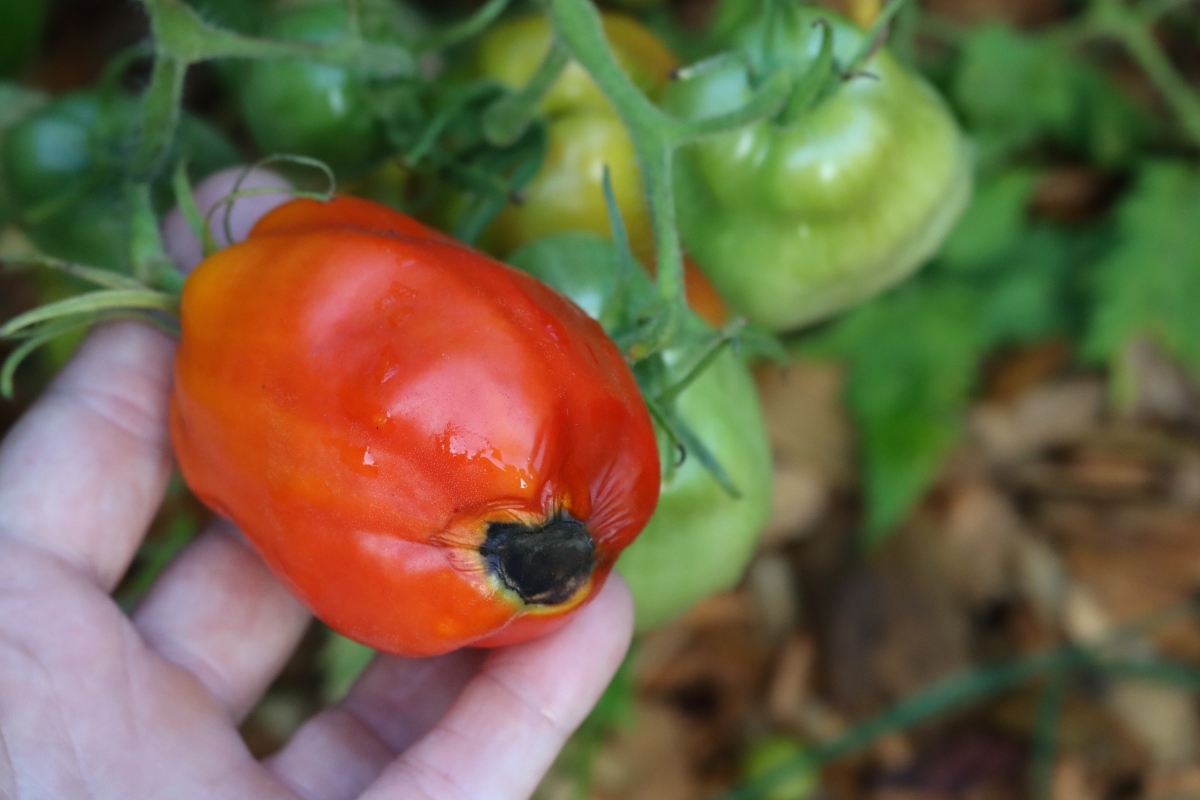
How to Organically Treat Blossom End Rot
The best treatment is pre-treating. You need to make sure your soil is rich and full of nutrients. Adding compost before planting or liquid calcium can ensure your plants can access all of the vitamins your tomatoes need.
- Mulch the soil. Doing so helps maintain even moisture levels rather than uneven, which can damage your plants’ abilities to take calcium.
- You can use a foliar spray that contains calcium chloride to prevent blossom end rot from developing in the mid-growing season. It’s best applied early in the morning.
- Come up with a watering schedule and stick to it to make sure the soil and plants are watered evenly.

Damping Off
A variety of different tomato viruses can cause this tomato disease. It affects young, healthy seedlings. Suddenly, your plants might have a dark lesion at the soil line, and before you know it, your plant wilts and dies.
Certain things increase the risk of damping off, such as:
- Cool conditions
- Consistently moist, cool soil
- Watering too much
- Overcrowding your garden beds or containers, decreasing air circulation
How to Organically Treat Damping Off
A lot of the ways to treat damping-off are simply good gardening techniques. Keeping your plants healthy is critical. Here are some things you should try.
- Use clean potting soil and clean, sterilized germination trays or tools.
- Don’t overcrowd your seedbeds or containers.
- Watch how you water your plants in the first two weeks after germination and sprouting.
Early & Late Blight
Blight comes in two forms – early and late. Early blight is caused by a fungus called Alternaria solani, and Phytophthora causes late blight.
Early blight is a widespread disease, and it infects the older, vulnerable lower leaves. That tends to be the starting point of infection. It starts as small, dark, and irregularly shaped lesions that gradually turn into larger rings.
As it keeps progressing, it kills the leaves and reduces the yields of the plant. This disease loves damp weather, living in the soil, or overwintering on diseased plants. Chances are your plants will survive, but you won’t have as many tomatoes as you would’ve had otherwise.
The same can’t be said for late blight.
Late blight is also a widespread disease. You’ll know that it’s this disease because it presents with wet or greasy-looking, greyish-black, or brown spots that are nickel-sized. White, fuzzy fungal growth will be on the leaves’ underside, and it infects the fruits. It’s not uncommon to find dark-colored lesions on the fruits.
Late blight spreads rapidly, and it’s quite destructive. Having late blight is bad news all around; there isn’t good news. It can quickly kill a mature plant in a week while spreading to all surrounding plants.
How to Organically Treat Early & Late Blight
Preventing is genuinely the best defense when it comes to blight. Keeping proper space between your plants is necessary for air circulation, and clearing your garden beds in the winter prevents giving spores anywhere to overwinter.
You also want to make sure you provide supports for your tomato plants. Any branches touching the ground increases the risk of contracting blight, and using mulch helps as well.
Here are some other suggestions.
- If you think you see early blight forming, you can use organic copper spray, and you also can use a biological fungicide but don’t use them in the same week. Spray the copper in the early morning; it reduces any harm to bees and other pollinators.
- For late blight, you can use an organic product called Actinovate, which contains a beneficial bacteria called Streptomyces lydicus; it works well as a preventative measure.
- Another option for late blight is Oxidate that is made of activated peroxide. It’s an effective preventative measure.
- Unfortunately, while these options work as preventative measures, you need to pull them out and toss them in the trash once it shows up on your plants. Never compost plants infected with blight because it’ll infect your plants when applying the finished compost to your garden.
Fusarium Wilt
This is a soil-borne fungus that typically attacks plants that belong to the same group, such as tomatoes, peppers, potatoes, and eggplants. The problem is that the fusarium wilt doesn’t appear immediately. In most cases, your plants won’t show any signs of a problem until they’re larger with nearly matured fruits.
It starts with your tomato plants looking fine, then all of a sudden, they begin to wilt. At first, the foliage might turn yellow only on one side, and if you cut open a stem, you’ll find brown or strange colored tissue. The fungus continues until your plant dies entirely.
How to Organically Treat Fusarium Wilt
- You should rotate crops each year and avoid planting any plants in the same family in these spots.
- Don’t spray the leaves with water, especially in cool weather.
- You can plant tomato varieties that are resistant to fusarium wilt.
Mosaic Virus
Several viruses are all related together; they’re all called tobamoviruses, and they all cause wilted, mottled, and fern-like leaves.
Mosaic virus spreads through mechanical means, so that means something that came in contact with this virus has to touch your uninfected plant. While it sounds hard, it’s not; it spreads that fast.
How to Organically Treat Mosaic Virus
- Believe it or not, tobacco can spread mosaic virus, so it’s important to never smoke near tomato plants. It’s considered unsanitary to do so.
- You should buy backyard plants from a reliable nursery or only use certified disease-free seeds.
- If you have infected plants, they need to be destroyed to stop the spread of the disease.
Verticillium Wilt
This is a fungus established in the soil, and once it’s present, it can be almost impossible to get rid of it. It can be hard to tell fusarium wilt and verticillium wilt apart because they have very similar symptoms. However, verticillium wilt isn’t as lethal in most cases.
The disease starts with the older leaves of the plants. You’ll notice the edges of the leaves turning yellow first. Eventually, they turn brown and crumble, and the stem shows signs of vascular damage. However, unlike fusarium wilt, this disease typically won’t kill your plants, but the yield will be lower.
How to Organically Treat Verticillium Wilt
- Make sure you don’t water the foliage, which can spread the fungus. Also, don’t overcrowd the plants because it reduces air circulation.
- It would be best if you planted resistant varieties to avoid encountering this fungus.
Treating Common Tomato Pests and Diseases
Despite being considered an “easy” vegetable to grow, tomato plants have several pests and diseases out there ready to take them down. The safest bet is to use healthy plant management techniques to prevent problems from appearing.
Always plant your tomatoes spaced out appropriately to provide ample air circulation. Lay down mulch and clear out garden debris at the end of the growing season. Water at the base of the stem rather than on the foliage. These are a few tricks that help to decrease problems arising.
Luckily, you can treat most tomato pests and diseases organically!
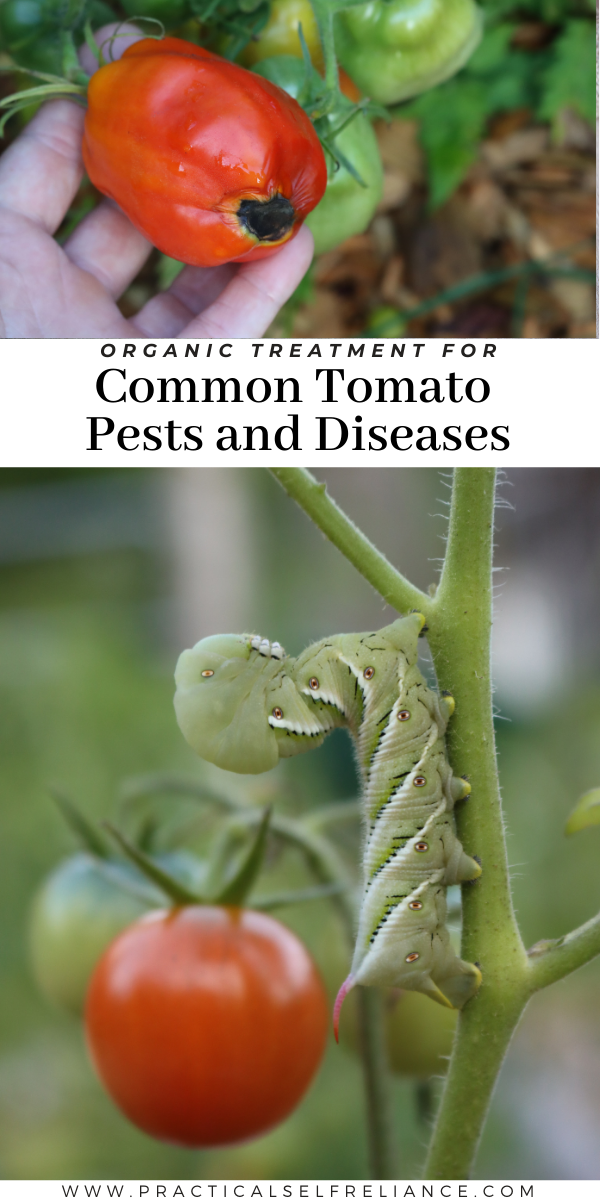

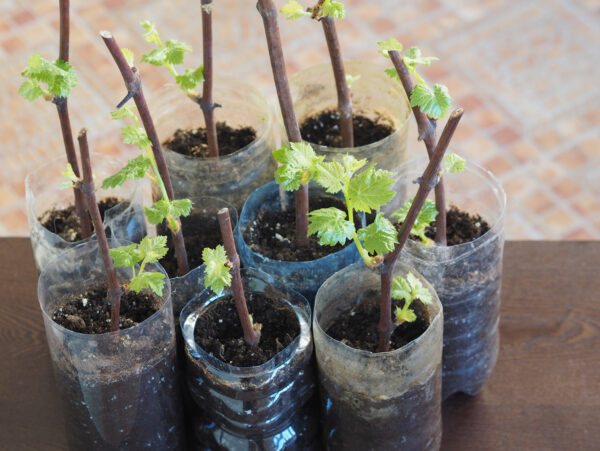
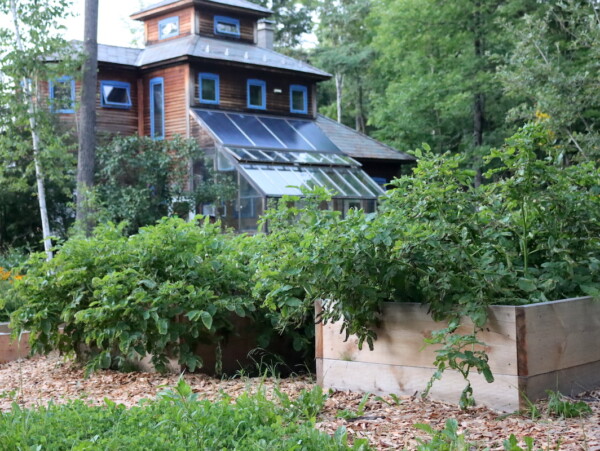
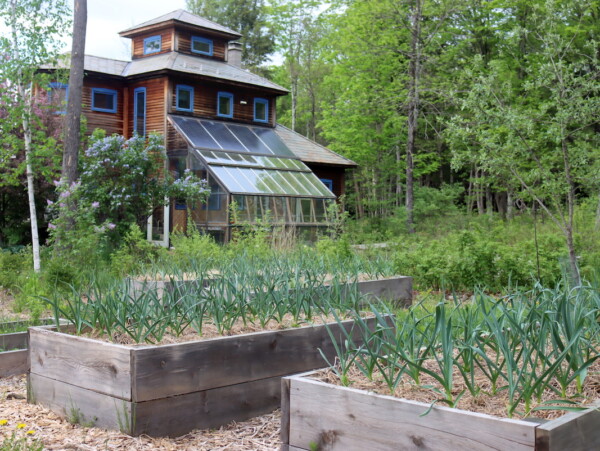
Thankyou for lesson/information grasped very well.
You’re quite welcome!
These pictures are of TOBACCO Hornworm, not tomato hornworm! I was mistaken for years about this species as well! It IS the one that does the damage though…..
Thank you for pointing that out. I didn’t even realize there was a tobacco hornworm or that there was a difference. We will make a note and try to update the post with that information.